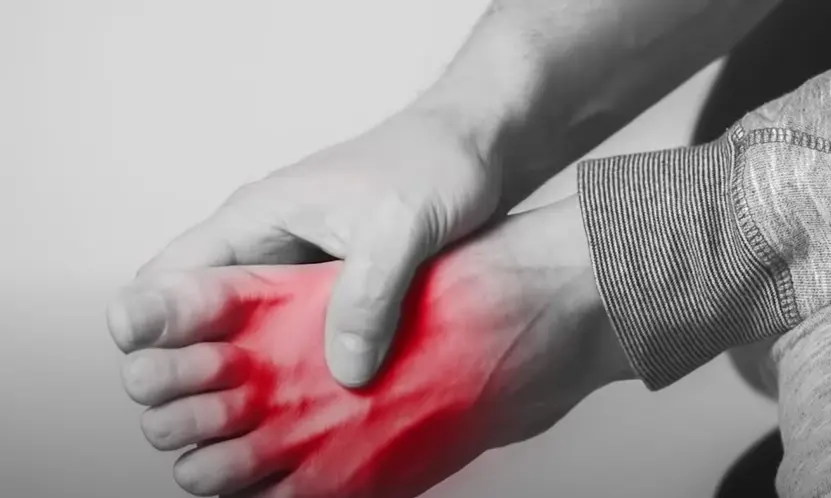Diabetes neuropathy usually damages nerves in the feet and legs, which may exacerbate its symptoms. Blood sugar levels can also damage tiny blood vessels within the nerves, leading to neuropathy and leg pain. Uncontrolled diabetes causes weight gain and joint problems, which can lead to heart disease.
Yes, diabetes can cause leg pain during cycling because of diabetic neuropathy. This condition arises from high blood sugar levels damaging the nerves, leading to pain, tingling, or numbness in the legs. Managing blood sugar levels effectively is crucial to delay or prevent diabetic neuropathy.
This article will explore the relationship between diabetes and leg pain during cycling and discuss strategies for managing this discomfort effectively.
Can Diabetes Cause Leg Pain Due to Cycling: 6 Reasons
In cycling, individuals with diabetes face unique challenges that can contribute to experiencing leg pain. Understanding the factors that play a role in this discomfort is crucial for diabetic cyclists to manage their condition effectively and enjoy the benefits of cycling without unnecessary pain. Here are some key contributing factors that can lead diabetic cyclists to experience leg pain:
Improper Cycling Techniques and Equipment
One significant contributor to diabetic cyclists’ leg pain is improper cycling techniques and equipment. When cyclists, especially those with diabetes, do not adhere to proper cycling forms or use ill-fitting equipment, they put undue stress on their legs.
It can cause muscle fatigue, strain, and leg pain. Ensuring diabetic cyclists are educated on correct cycling posture and using gear can significantly ease leg pain during and after cycling sessions.
Neuropathy and Nerve Damage

Nerve damage causes neuropathy, which can cause leg pain in diabetic cyclists. In diabetic neuropathy, nerves control muscle function and sensation in the legs, leading to discomfort, tingling, or numbness during cycling. The impaired nerve signals can cause muscle weakness and altered pain perception, increasing the risk of leg pain in diabetic cyclists.
Peripheral Artery Disease (PAD)
Peripheral artery disease (PAD) is a common complication of diabetes involving narrowed arteries that reduce blood flow to the legs. Diabetic cyclists with PAD may experience leg pain, cramping, or fatigue because of inadequate circulation during physical activity. A reduced oxygen supply to the muscles can lead to discomfort and limit cycling performance.
Blood Sugar Control
Another critical factor influencing diabetic cyclists’ leg pain is managing blood sugar levels before and during cycling. Blood sugar fluctuations can affect energy levels, muscle function, and overall performance during physical activity.
For diabetic cyclists,maintaining stable blood sugar levels through proper nutrition and monitoring is essential to prevent muscle cramps, spasms, and leg pain while cycling. Consistent blood sugar control before and during rides improves endurance and reduces leg discomfort.
Dehydration and Electrolyte Imbalance
Dehydration and electrolyte imbalance are common issues that diabetics may face, especially during physical exertion, like cycling. These conditions can directly affect muscle function and contribute leg pain. The balance of electrolytes and hydration is essential to muscle contraction, nerve function, and overall performance during exercise.
Diabetic cyclists should pay close attention to their fluid intake and electrolyte replenishment to minimize the risk of leg cramps, spasms, and discomfort while cycling.
Overweight and Obesity
Being overweight and obese poses an additional challenge for diabetic cyclists. Excess weight increases pressure on the legs, joints, and muscles during cycling, leading to more significant strain and potential pain.
Diabetic cyclists who are overweight may experience heightened discomfort in the legs because of the added stress on these areas. Managing weight through a combination of healthy eating habits and regular exercise can ease the strain on the legs and reduce the likelihood of leg pain during cycling sessions.
Inflammation and Overuse Injuries
Chronic inflammation and overuse injuries are common concerns for diabetic cyclists who engage in repetitive motion and prolonged cycling sessions. Inflammation in the legs’ muscles, tendons, or ligaments can result from microtrauma, poor recovery, or underlying inflammatory conditions exacerbating diabetes.
Managing Leg Pain While Cycling with Diabetes

For diabetic cyclists, managing leg pain is essential for a comfortable and rewarding ride. Cycling is good for your health but can also be challenging if you have diabetes, especially leg pain. Diabetic cyclists can achieve optimal health while pursuing their passion for cycling by addressing and easing leg pain. To manage leg pain when cycling with diabetes, follow these tips:
Medical Treatments
- Pain Management through Medication: Over-the-counter medications, such as acetaminophen and ibuprofen, may help ease
mild-to-moderate pain. The US Foods and Drug Administration (FDA) currently approves a combination of duloxetine and - Supplements: Certain dietary supplements may ease pain, including leg discomfort associated with diabetes. Nutrients can repair nerve tissues and even protect them from further damage. Alpha-lipoic acid (ALA), acetyl-L-carnitine, vitamin B-12, and vitamin D are being studied for diabetic neuropathy treatment.
Lifestyle Modifications
- Exercise regularly: Low-affected activities like walking, swimming, or cycling can improve blood flow and strengthen leg muscles. Regular exercise is another essential home remedy for managing diabetes leg pain.
- Stretching Exercises: Calves and thighs can benefit from stretching exercises to ease cramping and improve flexibility.
- Elevating your legs is an effective: Home remedy for reducing leg pain. This method can reduce swelling and improve circulation.
- Warm or Cold Compresses: Cold or warm compresses help reduce inflammation and relieve pain.
- Using a Leg Cradle at Night: A leg cradle can provide relief by keeping your legs elevated while you sleep. Swelling will go down, and blood circulation will improve, lessening the pain you’re experiencing.
- Massaging the Lower Legs: Regularly massaging your lower legs can help stimulate blood flow and relax muscles. This can be helpful after a long bike ride. You can do this yourself or see a professional massage therapist.
- Soaking the Feet in Warm Water: This is a simple and relaxing treatment option. The warmth of the water can help soothe your muscles and improve circulation in your feet. Just fill a basin with warm water, sit back, and let your feet soak for 15-20 minutes.
Cycling-Specific Strategies

- Monitor Blood Sugar Levels: Always check your sugar before and after cycling. This will assist you in managing your diabetes and prevent fluctuations that could exacerbate leg pain.
- Stay Hydrated and Maintain Nutrition: Consume small amounts of sugar frequently to keep your energy levels high. If you are cycling for a short time, a sugar drink can be consumed halfway through the ride. Longer rides will require frequent blood testing.
- Carry Necessary Supplies: Always carry substantial fuel to last the duration of the trip and a suitable supply of insulin in case you measure any highs when testing your blood.
- Monitoring Blood Sugar Levels: To manage cycling-related leg pain caused by diabetes, diabetic cyclists should monitor their blood sugar levels before, during, and after rides. A stable blood sugar level can keep muscle cramps, fatigue, and leg discomfort at bay.
Conclusion
Diabetes can indeed be a root cause of leg pain during cycling. The culprit typically lies in a combination of factors such as uncontrolled blood sugar levels, neuropathy, and even the extra strain caused by being overweight. But let’s remember, every cloud has a silver lining.
You can manage this discomfort by maintaining stable blood sugar, exercising regularly, and ensuring proper hydration. Cycling is enjoyable and beneficial, and diabetes should not diminish the joy and freedom it brings. So gear up, pedal on, and embrace the ride.
FAQs
What Should Diabetics Eat While Cycling?
Exercise can worsen blood glucose control if it’s over 250 mg/dl. Eat foods with a lower glycemic index. Breakfast options include oatmeal (the long-cooking kind, not instant), oat bran, muesli (no sugar), milk, yogurt, fruit, and juice.
Is Cycling Good For Type 2 Diabetes?
People with diabetes can benefit from all kinds of physical activity, regardless of their diabetes type. Moving more and trying things like cycling improves insulin sensitivity.

![7 factors that contribute to leg pain caused by diabetes during cycling [Management Tips]](https://cacyclinghub.com/wp-content/uploads/2024/05/Can-Diabetes-Cause-Leg-Pain-Due-to-Cycling-e1717563540119.webp)
